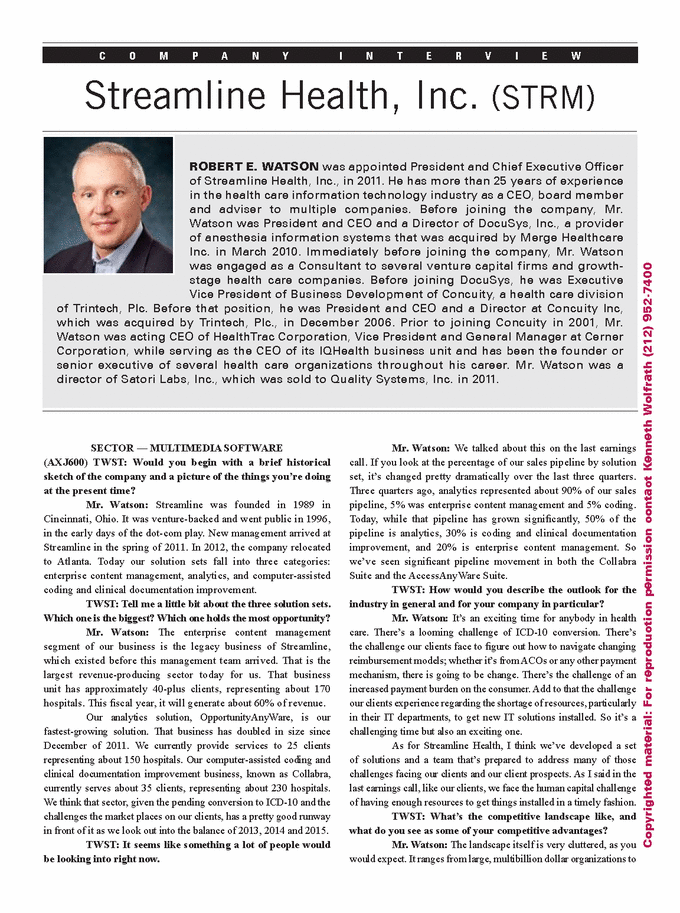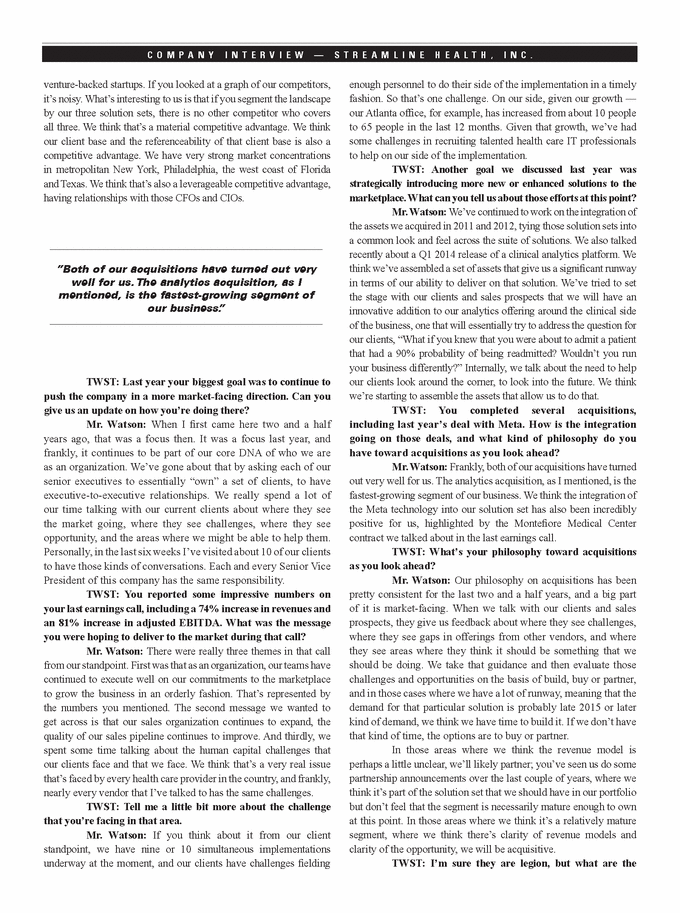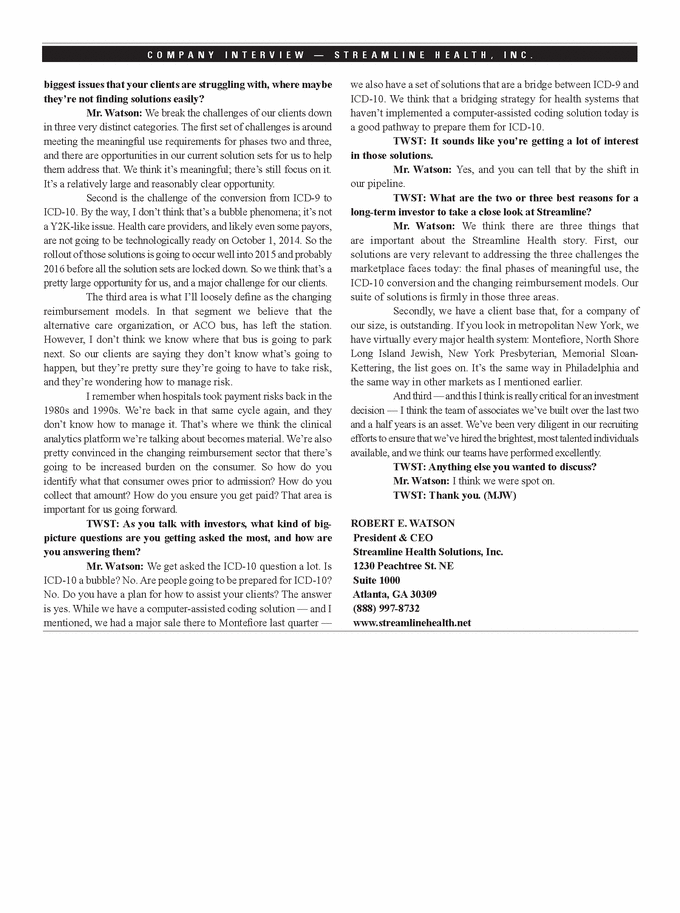
| COMPANY INTERVIEW Streamline Health, Inc. (STRM) ROBERT E. WATSON was appointed President and Chief Executive Officer of Streamline Health, Inc., in 2011. He has more than 25 years of experience in the health care information technology industry as a CEO, board member and adviser to multiple companies. Before joining the company, Mr. Watson was President and CEO and a Director of DocuSys, Inc., a provider of anesthesia information systems that was acquired by Merge Healthcare Inc. in March 2010. Immediately before joining the company, Mr. Watson was engaged as a Consultant to several venture capital firms and growth- stage health care companies. Before joining DocuSys, he was Executive Vice President of Business Development of Concuity, a health care division of Trintech, Plc. Before that position, he was President and CEO and a Director at Concuity Inc, which was acquired by Trintech, Plc., in December 2006. Prior to joining Concuity in 2001, Mr. Watson was acting CEO of HealthTrac Corporation, Vice President and General Manager at Cerner Corporation, while serving as the CEO of its IQHealth business unit and has been the founder or senior executive of several health care organizations throughout his career. Mr. Watson was a director of Satori Labs, Inc., which was sold to Quality Systems, Inc. in 2011. SECTOR — MULTIMEDIA SOFTWARE (AXJ600) TWST: Would you begin with a brief historical sketch of the company and a picture of the things you’re doing at the present time? Mr. Watson: Streamline was founded in 1989 in Cincinnati, Ohio. It was venture-backed and went public in 1996, in the early days of the dot-com play. New management arrived at Streamline in the spring of 2011. In 2012, the company relocated to Atlanta. Today our solution sets fall into three categories: enterprise content management, analytics, and computer-assisted coding and clinical documentation improvement. TWST: Tell me a little bit about the three solution sets. Which one is the biggest? Which one holds the most opportunity? Mr. Watson: The enterprise content management segment of our business is the legacy business of Streamline, which existed before this management team arrived. That is the largest revenue-producing sector today for us. That business unit has approximately 40-plus clients, representing about 170 hospitals. This fiscal year, it will generate about 60% of revenue. Our analytics solution, OpportunityAnyWare, is our fastest-growing solution. That business has doubled in size since December of 2011. We currently provide services to 25 clients representing about 150 hospitals. Our computer-assisted coding and clinical documentation improvement business, known as Collabra, currently serves about 35 clients, representing about 230 hospitals. We think that sector, given the pending conversion to ICD-10 and the challenges the market places on our clients, has a pretty good runway in front of it as we look out into the balance of 2013, 2014 and 2015. TWST: It seems like something a lot of people would be looking into right now. Mr. Watson: We talked about this on the last earnings call. If you look at the percentage of our sales pipeline by solution set, it’s changed pretty dramatically over the last three quarters. Three quarters ago, analytics represented about 90% of our sales pipeline, 5% was enterprise content management and 5% coding. Today, while that pipeline has grown significantly, 50% of the pipeline is analytics, 30% is coding and clinical documentation improvement, and 20% is enterprise content management. So we’ve seen significant pipeline movement in both the Collabra Suite and the AccessAnyWare Suite. TWST: How would you describe the outlook for the industry in general and for your company in particular? Mr. Watson: It’s an exciting time for anybody in health care. There’s a looming challenge of ICD-10 conversion. There’s the challenge our clients face to figure out how to navigate changing reimbursement models; whether it’s from ACOs or any other payment mechanism, there is going to be change. There’s the challenge of an increased payment burden on the consumer. Add to that the challenge our clients experience regarding the shortage of resources, particularly in their IT departments, to get new IT solutions installed. So it’s a challenging time but also an exciting one. As for Streamline Health, I think we’ve developed a set of solutions and a team that’s prepared to address many of those challenges facing our clients and our client prospects. As I said in the last earnings call, like our clients, we face the human capital challenge of having enough resources to get things installed in a timely fashion. TWST: What’s the competitive landscape like, and what do you see as some of your competitive advantages? Mr. Watson: The landscape itself is very cluttered, as you would expect. It ranges from large, multibillion dollar organizations to Copyrighted material: For reproduction permission contact Kenneth Wolfrath (212) 952-7400 |



